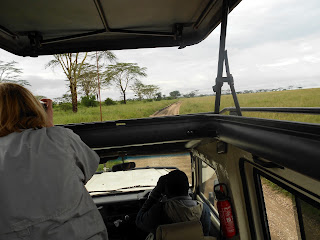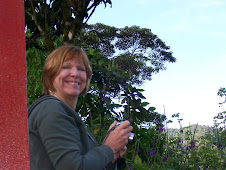Looking into the Ngorongoro Crater from our lodge
It was 5:30 am and slightly drizzling and extremely foggy when we left our hotel to drive down into the crater for our early morning game drive. Visibility was about non-existent and knowing that we were driving on a very narrow slippery road down 2000 feet made for a very scary ride. It seemed to take forever. When I looked out the window it seemed we were shrouded in clouds. I don't know how Frank could tell where he was driving, but he got us to the bottom safely and soon thereafter the sky creared and we were treated to a sunrise in the crater.
From the floor of the crater in early morning
Standing in the center of the crater all the facts I had learned about the crater became amazingly real. This place was created by a giant volcano that exploded and collapsed on itself 3 million years ago. It is 2000 feet deep and the floor is an unbroken, unflooded caldera that covers 100 square miles. The rim of the crater rises up on all sides. The place is a geological wonder. It is believed by many to be the true garden of eden. While most of the area is open grassland there is also a salt lake and a fresh water stream that feeds a tropical forest, as well as a few other small lakes. As the sun rises over the rim of the crater the scene comes to life and birds and animals appear everywhere.
The first we saw was the majestic elephant.
Black Backed Jackal
In the forest we were treated to this graceful Pin-Tailed Whydah,
and this handsome Waterbuck.
Back out on the open grassland we saw this mother and juvenile Black Rhino, a true find.
We saw this and much more before breakfast. By 9 o'clock our stomachs were growling so we stopped by a beautiful little lake and had "breakfast on the bonnet." Sometimes it is more about where you eat than what you eat. In this case we enjoyed our hardboiled eggs and beef sausage near a lake with hippos and herons.
Coffee in the Crater
After breakfast we headed out again and for the next few hours were delighted with close up views of lions, wildbeest, zebras, hyenas, elands, Thompson's Gazelle, hippos, jackals, cape buffalo and elephants. We even had a distant and brief view of a cheetah. Of course we also saw lots of birds. Here are a few of the hundreds of pictures I took.
Augur Buzzard
Zebra
Lions! I learned that lions do an awful lot of just lying around and sleeping.
The lions were so close to our truck it should have seen scary, but they were so slow and sleepy they didn't seem to pose any threat.
I actually saw enough lions to satisfy my desire to see them.
Zebras in front, Flamingos in the back.
Grey Crowned Crane
White- bearded Wildebeest
By the time we left the crater it was light and I was able to see what I missed driving into the crater in the morning fog. Although breathtaking, I'm not sure if it is better to see or not see the drive along narrow steep roads. At any rate, we returned to our lodge where I sat with a double gin and tonic and recorded the days events. This had to be the best view of the trip.
As the clouds shifted and cleared, I could actually look back down into the crater and with binoculars see the elephants roaming the plain.
up next...the Serengeti.




















































